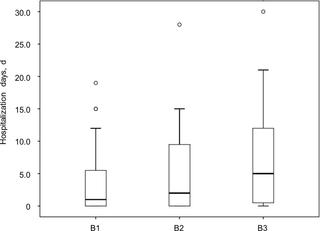PLOS ONE ( IF 3.7 ) Pub Date : 2019-01-16 , DOI: 10.1371/journal.pone.0210703 Gunn Huh , Hyuk Yoon , Yoon Jin Choi , Cheol Min Shin , Young Soo Park , Nayoung Kim , Dong Ho Lee , Joo Sung Kim

|
Background
The use of biologics in inflammatory bowel disease (IBD) has increased recently. However, studies on whether the proportion of IBD patient visits to the emergency department (ED) has decreased are scarce. We investigated the trends in IBD-related ED visits and hospitalization rates.
Methods
Medical records of IBD-related visits to the ambulatory department (AD) and the ED of the Seoul National University Bundang Hospital in 2007, 2009, 2012, and 2014 were reviewed. Multiple-variable logistic regression analysis was used to identify significant risk factors for hospitalization.
Results
The proportion of IBD patients who visited ED was 12.3% in 2007, 9.7% in 2009, 8.3% in 2012, and 6.4% in 2014 (P = 0.002). The most common chief complaints were abdominal pain (66.9%) in Crohn’s disease (CD) patients and hematochezia (36.5%) in ulcerative colitis (UC) patients. The hospitalization rate following ED visits was 47.2% in CD patients and 55.6% in UC patients (P = 0.100). Multiple-variable analysis showed that significant risk factors associated with hospitalization in CD were aggressive disease behavior (odds ratio[OR] 3.54, P = 0.017) and presence of steroid exposure (OR 2.35, P = 0.047). Elevated C-reactive protein (CRP) (>0.5 mg/dL) (OR 5.40, P = 0.016) was the only risk factor associated with hospitalization in UC.
Conclusions
The proportion of ED visits decreased from 2007 to 2014; there was no significant change in hospitalization rates. Disease behavior/presence of steroid exposure and elevated CRP were associated with hospitalization among CD and UC patients who visited the ED, respectively.
中文翻译:

生物制剂时代急诊就诊和炎症性肠病住院率的趋势
背景
最近,在炎症性肠病(IBD)中使用生物制剂的情况有所增加。然而,关于IBD患者到急诊室就诊的比例是否减少的研究很少。我们调查了与IBD相关的急诊就诊和住院率的趋势。
方法
回顾了2007年,2009年,2012年和2014年IBD相关访问首尔国立大学盆唐医院门诊部和急诊室的病历。使用多变量逻辑回归分析来确定住院的重大危险因素。
结果
2007年,接受ED治疗的IBD患者比例为12.3%,2009年为9.7%,2012年为8.3%,2014年为6.4%(P = 0.002)。最常见的主要主诉是克罗恩病(CD)患者的腹痛(66.9%)和溃疡性结肠炎(UC)患者的便血(36.5%)。急诊就诊后,CD患者住院率为47.2%,UC患者为55.6%(P = 0.100)。多变量分析显示,与CD住院相关的重要危险因素是侵略性疾病行为(优势比[OR] 3.54,P = 0.017)和类固醇暴露的存在(OR 2.35,P = 0.047)。C反应蛋白(CRP)升高(> 0.5 mg / dL)(OR 5.40,P = 0.016)是与UC住院相关的唯一危险因素。
结论
从2007年到2014年,急诊就诊的比例有所下降;住院率没有显着变化。疾病行为/类固醇暴露的存在以及CRP升高与分别去ED的CD和UC患者的住院治疗有关。


























 京公网安备 11010802027423号
京公网安备 11010802027423号